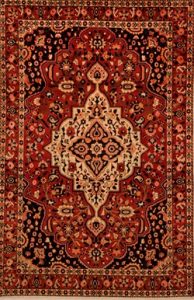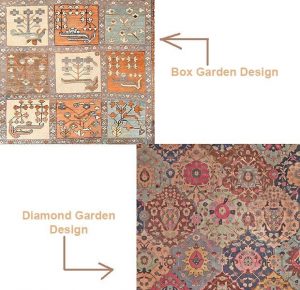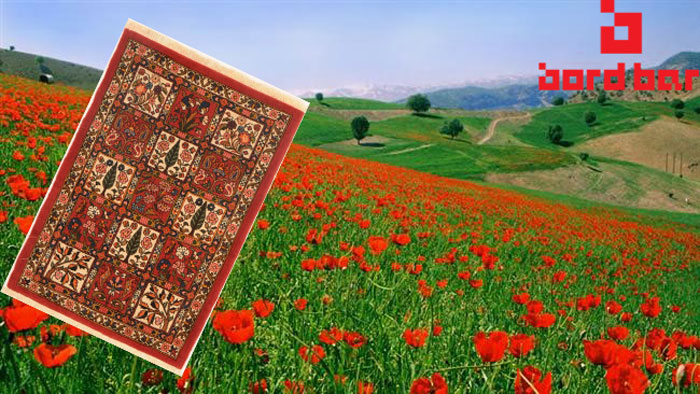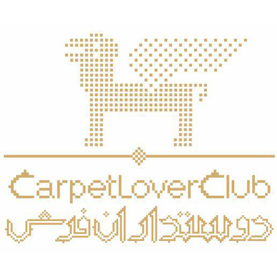Hallmarks of Weaving
Weaving is an important part of Bakhtiari households. The rugs that are made are quite original. They are distinguishable from others by weaving techniques, color preferences and design. Often Bakhtiari rugs are easily recognized by certain motifs and application of particular trees or flowers. For example, weeping willow and cypress trees play an important part in design. Perhaps one could generalize that, unlike some other Persian rugs such as Nain , Bakhtiari rugs are very colorful. In the past, particularly the rugs made over fifty years ago, vegetable dyes were used. The colors are usually black, blues, greens, brown, taupe, white, reds, orange and yellow. Some of these colors are natural, such as brown, black and white. Others were made from vegetables, plants and fruit shells in the surrounding nature. The origin of some of these dyes are as follows: Indigofera tentoria for light blue, rhamnus chlorophorus for green, walnut shell or oak shell pysbalit for brown, rubia tinctorum for red, pomegranate shell, delphinium zalil, gandal for yellow. There is another red that they get from an insect or coccus cati. Based on primary colors, they come up with other new colors such as making rose or pink by diluting red. However, today most of these more complicated techniques are abandoned and chemical dyes acquired by settlers are substituted.
Bakhtyari Rugs: The Brightest And Most Colorful Of All Nomadic Rugs

Bakhtyari rugs are hand woven by the Bakhtyari tribe, one of the oldest and most well known Persian tribes. Formerly nomadic by nature, around the 19th century the Bakhtyari tribe eventually established a settlement in the Zagros region, southwest of Isfahan. After they had settled down, the production of rugs increased tremendously and the rugs that were produced were of much higher quality too. Today there are almost 200 rug-weaving villages in this area and some of the most charming rugs you can find anywhere are produced in this region. The center of the Bakhtyari weaving area is now in Shahr-Kurd, southeast of Isfahan.
Designs Of Bakhtyari Rugs

Although the rugs created in the different villages have slight variations, all Bakhtyari rugs are brightly colored and have busy patterns that are mostly geometric and occasionally semi-geometric. Most rugs will have a very conspicuous checkerboard or latticed garden design with a variety of bird, animal or plant motifs filling each square or compartment. The compartments can be square, diamond, or hexagonal in shape. An interesting feature of these rugs is that each compartment will usually present a different motif and color scheme from that of the neighboring compartment. The end effect is a mesmerizing medley of designs and colors that can have you looking at it for hours as you inspect all of the variations. The most popular design is the ‘Kheshti’ design which consists of a garden field with compartments or squares filled with roses, flowers and tendrils. Another popular design is that of a decorated field with floral ornaments and lattice designs. The roses and pattern of these rugs clearly reflects the influence of Aubusson and French rug making. Most of the older Bakhtyari rugs feature beautifully rendered design elements from Persian flora and fauna. However in recent years artisans have adapted the design to meet the variety of demands of the world carpet market by also making rugs without this traditional motif. Unlike most other Persian rugs, curvilinear designs are very rare in Bakhtyari rugs although geometric designs can sometimes be seen.
‘Kheshti’ carpets

‘Kheshti’ carpets have the most popular designs among Bakhtiari rugs. In Kheshti design, various motifs of birds, animals or plants are placed in the squares or compartments of a very conspicuous checkerboard or latticed garden. An interesting feature of such rugs is that each compartment will usually present a different motif and color scheme from that of the neighboring compartment. The end effect is a mesmerizing medley. The floral designs of a Kheshti garden are roses, flowers and tendrils. Old Bakhtiari rugs usually feature beautifully rendered design elements from Iran flora and fauna. But unlike most Persian rugs, curvilinear designs are rare in Bakhtiari rugs.
“Garden” Concepts
The Garden of Paradise image has excited artists and artisans through many centuries. In the rug industry, specifically, various forms of the garden carpet have been created as a manifestation of Pardis garden by rug designers and weavers to immortalize their imagination of the concept. Accordingly, traditional Persian carpets were often influenced by the Garden of Paradise idea. One example is the pattern called a “garden carpet,” with imaginary trees and flowers, and usually with no center medallion. Occasionally the design is presented as a single imaginary tree with branches, leaves, flowers, and birds, often called the “Tree of Life” pattern. Some of these rugs are designed with a multitude of blocks, with each block presenting a different part of the garden. This style is called a Kheshti rug. Sometimes rugs were made in the form of Chahar Bagh, or the four-fold garden. The Chahar Bagh usually is a rectangle divided symmetrically into four parts, with two crossing canals forming the division lines and a pond as the center focal point. Trees and birds fill each of the four sections. Sometimes this style is interpreted as a Chahar Fasl, or four seasons design. Design elements in garden carpets are usually a cross section of the elements of a garden—water, trees, flowers, and birds or animals. For example, in many Bakhtiari rugs you find cypress trees, weeping willows, pines, and roses. However, these constituent elements of a garden are sometimes transformed into abstract forms, according to the perceptive imagination of the weavers.
Distinctive Colors of Bakhtyari Rugs
The weavers of this region use a wide range of colors when weaving these rugs. The dyes used always natural with the principal colors being varied shades of white and ivory. Other common colors include various shades of red, yellow, green and brown
Construction of the Rug
Bakhtyari rugs are thick, solid, sturdily knotted and rank among the brightest and most colorful of nomadic Persian rugs. The Bakhtyari weavers were primarily shepherds and each weaver usually used wool obtained from their own herd. This region is known for having very luxurious wool that produces excellent rugs. The pile is generally clipped medium high to high. Bakhtiari-style rugs have another branch of rugs called “Bibibaff.” These are only made by women and are considered among the finest and most traditional of the rugs from the Chahar Mahal region. Other high quality rugs from this region are the Saman and Chapel Shotur varieties.
BAKHTIARI Persian Rugs Properties
- Visibility: The best known BAKHTIARI rug design is the Garden carpet with flower- and tendril-filled compartmental designs (KHESHTI Design). Another important BAKHTIARI design consists of a decorated field with lattice designs and floral ornaments that are as distinctly executed as the well-drawn medallion carpets of Saman.
- Quality: There is a wide variation in quality and prices among carpets from this region, ranging from consumer carpets up to excellent collector’s pieces. Hori carpets are generally of lower quality, while Bibibaff, Chapel Shotur and Saman pieces are good to excellent.
- Size & Shapes: Small and Large rugs up to 1.50 x 2.20m and occasionally narrow runners are produced. Room-sized carpets up to 4 x 5m are woven in workshops.
- Color: There is great variety of color in the carpets produced in the several hundred villages of this area. The principal colors include many shades of white and ivory, as well as various reds, browns, greens, and yellows, but relatively little blue. Natural dyes generally produce a harmonious range of color, especially on older pieces and in Bibibaff.
- Texture: Even with wool obtained from the weaver’s own herd, there are still varying degrees of quality, ranging from dull to extremely glossy. The pile is clipped medium-high to high.
- Foundation: Warp and weft are of cotton.
- Knots: The Turkish knot is used in greatly varying knot densities, ranging from very coarse to medium fine.
- Price: Old and antique BAKHTIARI rugs are sought as rather rare collectors’ pieces. Nomad carpets have a special charm and are distinguished by their beautiful patina. Old Bakhtiari are high in price, but newer ones are fairly reasonable.




